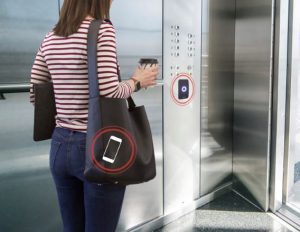
While touch-free access control has been gaining popularity for years, the technology has really seen a surge in the midst of the coronavirus pandemic. According to research firm Future Market Insights, the touch-free market is now projected to grow 17.4 percent in the next ten years, reaching a value of more than $70 billion.
It’s no mystery why this is — who today feels comfortable touching the door handle in a public restroom? Now that we are so painfully aware of how easy disease can spread, security must be taken to the next level, and ensure visitors and employees are just as safe from viruses as they are from intruders.
Here are some of the innovative new touchless technologies being used for access control:
1. Wave-to-Open Door Sensors
Wave-to-open doors are older than most touchless technologies, but they get the job done. Using motion sensing technology, touchless ‘zones’ can be adjusted to create the range in which a person must be within for their wave to be detected. So while they may not be the fanciest, wave-to-open doors are a simple, hands-free solution that lends itself to restrooms, restaurants, schools, hospitals, and more.
2. Mobile Credentials
While mobile access control isn’t completely touch-free, users only have to touch their phone, still taking away the point of contamination. With mobile access, each user has their own access credentials, and can use their mobile phones (usually an app) to open doors. This is one of the most secure forms of access control, since these credentials are typically highly secure, with advanced authentication and encryption. Mobile credentials also give users the ability to remotely lock and unlock doors.
3. Contactless Fingerprint Sensors
Fingerprint sensors may not sound like a touch-free technology, but thanks to recent innovations, there are now fingerprint sensors that do not require contact. A single hand movement over a contactless scanning surface can instantly identify who is attempting to enter a building, providing a fast and convenient access control solution.
4. Iris Scanners
Iris scanners, another touch-free biometric solution for access control, provide highly accurate identification by the iris of the eye. Every iris pattern is unique, just like every fingerprint, but unlike fingerprints, the iris never changes over time, making this an effective solution for a variety of use cases, especially industries wherein visitors or employees may wear gloves or have dirty hands, such as factories or farms.
5. Facial Recognition
Using artificial intelligence, facial recognition technology is an incredibly effective access control solution. Facial recognition systems can be anchored to a wall, turnstile or speed-gate, and use a camera to scan visitors’ faces. Advanced AI algorithms then map and detect the features that make that face unique. The recognition system then translates those features into hundreds of data points, representing the unique geometry of the face. And while the system does all that work, all the visitor has to do is stand in front of the scanner.
6. Wearables
A smart device that can be worn on the wrist, strung on a necklace or clipped onto a key ring, wearables take the method of using mobile phones for access control a step further, by making those access credentials even more accessible. Smart watches and personal biometric devices are the most common wearables in use today, but the extended use of wearables for enterprise access solutions is gaining ground.
7. Touchless Turnstiles
While wave-to-open doors require that the door remain open for at least 10 seconds before closing, automatic turnstiles and revolving doors operate under different guidelines, eliminating the possibility of intruders tailgating (following someone through an entrance without permission). With this added level of safety and security, automatic turnstiles are a good fit for hospitals, schools, and airports.
Since the start of the COVID-19 crisis, many manufacturers have been hard at work to come up with newer, even more innovative touchless access control solutions. These technologies offer companies and organizations an opportunity to make real changes to the safety of their buildings and can help build back the trust needed to return to public spaces.
Now more than ever its critical to react quickly and be open to change in order to minimize spread and ensure safety. With new options like contactless fingerprint sensors and wearable devices for access, technology gives us the power to build a better, safer environment to return to. No matter which technology you choose to secure your building, there is no denying that the future of access control is touchless.
3Sixty Integrated is committed to work in collaboration with companies and organizations to design, install and manage a security system built for the post-COVID-19 world. Partnering with an experienced integrator, like 3Sixty Integrated, offers the flexibility to be nimble in a changing situation and the knowledge to guide you every step of the way. Feel free to contact us at (210) 545-1770.
More sources on electronic security:
Security Strategies for Reopening K-12 Schools in a COVID-19 World
How To Create A Corporate Physical Security Strategy
Top 3 Best Practices for Security Professionals to Implement During the Coronavirus Outbreak

